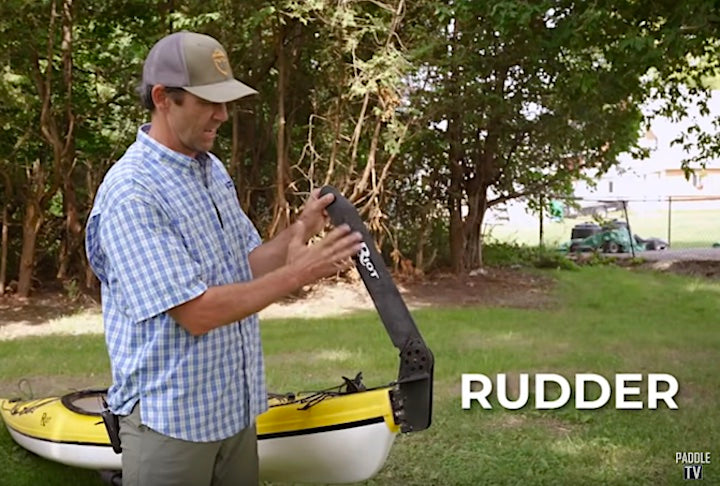Kayak Rudders & Skegs FAQs

Join Aqua Bound ProStaffer Ken Whiting as he explains kayak rudders and skegs in this video from Paddle TV…
What’s the Difference Between a Rudder and a Skeg?
A rudder is housed at the top of the stern end of the kayak, and can be lowered or lifted by cables along the sides. You use the rudder for steering by using the foot pedals.

A skeg drops down from its housing underneath the stern of the kayak, also using a hand cable. Skegs don’t turn, though, so they won’t help with steering—in fact, it may interfere with steering if it isn’t used properly. It helps keep your kayak tracking straight ahead.

Why Use a Rudder or Skeg?
Can you kayak without a rudder or skeg? Of course. Developing your paddling skills is one of the most important things you can do to be a proficient kayaker. So learn to handle your kayak efficiently without a skeg or rudder and you can handle just about any water situation.
But there are some instances when using a rudder or skeg is really helpful. The most common is with “weather cocking.”
How Weather Cocking Affects Your Paddling and How to Counteract It
Weather Cocking happens when you’re kayaking with a stiff side wind and your bow keeps turning into the wind. This has to do with the physics of the water along the bow.
If you’re not paddling far, it’s probably not a big deal. But say you’re on a multi-day kayak camping trip and need to cover several miles a day. Constantly adjusting your strokes to deal with weather cocking can get exhausting.
If you’re a very confident kayaker, you can lean toward the wind a bit as you paddle, and that’ll keep your kayak tracking straighter.
But having a rudder or skeg is a super helpful way to track straight toward your destination with less effort.
If you have a rudder on your kayak, you can use your feet to steer it away from the wind a bit as you paddle. That’ll help balance out the weather cocking. If you use a skeg, you can adjust how far it goes into the water, depending on how much help you need.
Are There Disadvantages of Using Rudders and Skegs?
Rudders and their cables are fairly delicate and prone to breaking. So you’ll want to treat the system well if your kayak has one, or if you decide to buy a kayak that has one.
You’ll also need to be careful where you walk, as it’s not hard to hit your head or leg on the rudder as you move around your kayak either strapped on your vehicle’s roof or when it’s on the ground.
The issue you may run into with a skeg is the space it takes up inside the stern storage compartment. If every square inch counts to pack gear for a trip, that may be a disadvantage for you.

What Length Kayaks Need a Rudder or Skeg?
Shorter kayaks—under 14 feet—don’t need them. The longer sea kayaks are the ones where they come in more handy, especially if you plan to use it for lots of long mileage trips. Longer kayaks are more challenging to steer, so you may want the extra help.
Rudders are a great option in the longer tandem kayaks, although with some stroke knowledge, again, not absolutely necessary.
Should You Add a Rudder or Skeg to Your Kayak?
While it’s theoretically possible to add a rudder or skeg to a kayak, whether you do it or not is another question. It involves drilling holes and other operations that could compromise the structure, especially as many of these are near or under the water line.
Ken recommends not adding one, but instead look for a used kayak that has one or the other if that’s what you want. There are plenty of them out there!
Let us help you choose your (next) kayak paddle! Contact our friendly Customer Service team today: 715-755-3405 • sales@aquabound.com
More for you...





